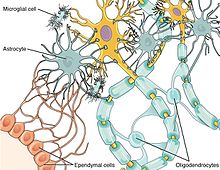Brain cell
| Brain cell | |
|---|---|
myelin sheath. | |
| Anatomical terms of microanatomy] |
Brain cells make up the
Neurons are the
Glia are the supporting cells of the neurons and have many functions not all of which are clearly understood, but include providing support and nutrients to the neurons. Glia are grouped into
Cell types

Brain cell types are the functional neurons, and supporting glia.
Neurons
Cortical interneurons only make up around a fifth of the neuronal population but they play a major role in modulating cortical activity needed for cognition and many aspects of learning and memory. Cortical interneurons vary in shape, molecular make-up, and electrophysiology; they function collectively to maintain the balance between excitation and inhibition in the cortex primarily through the use of GABA. Disruption of this balance is a common feature of neuropsychiatric disorders such as schizophrenia. A cause of the disruption can occur in prenatal development through the exposure to chemicals and environment.[6]
In the
Glia

Glial cells are the supporting cells of the neurons.
References
- ^ ISBN 9780878936953.)
{{cite book}}: CS1 maint: location missing publisher (link - PMID 31212931.
- ISBN 9780878936953.
- ^ PMID 31145508.
- ^ ISBN 9780123858702.)
{{cite book}}: CS1 maint: location missing publisher (link - PMID 27932026.
- ^ S2CID 23182200.
